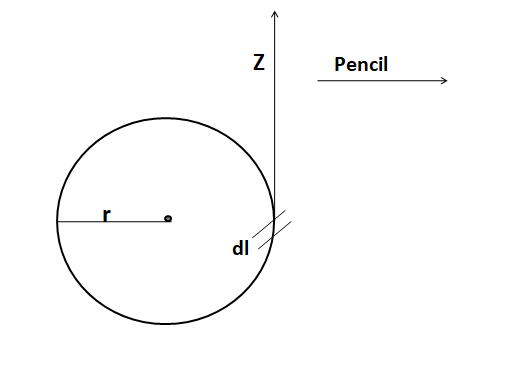
The work done by the frictional force on a surface in drawing a circle of radius r on the surface by a pencil of negligible mass with a normal pressing force N (coefficient of friction ${\mu _k}$) is:
A) $4\pi {r^2}{\mu _k}N$
B) $ - 2\pi {r^2}{\mu _k}N$
C) $ - 2\pi r{\mu _k}N$
D) Zero
Answer
147k+ views
Hint: In this question, the concept of friction force is applied, that is the friction force is the product of the coefficient of friction and the normal force exerted on the body or the object. First, draw the diagram using all the information given in the question and then find out the work done by the frictional force in drawing a circle of radius and discuss the derivation.
Complete step by step answer:
As per the given question first, we will draw the diagram as per the given situation.

The motion of the pencil is in the $z$ direction. The given radius of the circle is $r$. The friction of motion will be tangentially.
So, we have to derive the work done at $dl$ length.
We know that the work done at length $dl$ can be written as
${\rm{dw = }}\;{\rm{ - }}{{\rm{f}}_k}.dl$
Here, the force of friction is ${{\rm{f}}_k}$.
As we know that the frictional force is always opposing the relative motion of the body so it is negative. Now, we integrate the above equation as,
$\int {dw\; = \;w} $
$ \Rightarrow \;w\, = - \int {{{\rm{f}}_k}.dl} $
We know that the friction force is the product of the coefficient of friction and the normal force exerted on the body or the object so,
${{\rm{f}}_k}\; = \;{\mu _k}{\rm{k}}$
Where, ${\mu _k}$is coefficient of friction and N is the pressing force.
Now we will substitute the value of friction force in the work done equation as,
$w\; = \, - \int {{\mu _k}{\rm{Ndl}}} $
The total length of the circle is $2\pi r$ . So to find out the total work done at length $dl$,we have to integrate from $0$ to $2\pi r$, so the above equation become,
$w\, = \, - \int\limits_0^{2\pi r} {{\mu _k}{\rm{Ndl}}} $
We integrate the above equation as,
$w\, = \, - {\mu _k}{\rm{N}}\left[ {2\pi r - 0} \right]$
$w\, = \, - 2\pi r{\mu _k}N$
Hence the correct option is (C).
Note: When a body is dragged along a rough surface, the frictional force will be acting in the direction opposite to the displacement of the body. And the angle between the displacement of the body and frictional force will be $180^\circ $. Hence the total work done by the frictional force will be negative.
Complete step by step answer:
As per the given question first, we will draw the diagram as per the given situation.

The motion of the pencil is in the $z$ direction. The given radius of the circle is $r$. The friction of motion will be tangentially.
So, we have to derive the work done at $dl$ length.
We know that the work done at length $dl$ can be written as
${\rm{dw = }}\;{\rm{ - }}{{\rm{f}}_k}.dl$
Here, the force of friction is ${{\rm{f}}_k}$.
As we know that the frictional force is always opposing the relative motion of the body so it is negative. Now, we integrate the above equation as,
$\int {dw\; = \;w} $
$ \Rightarrow \;w\, = - \int {{{\rm{f}}_k}.dl} $
We know that the friction force is the product of the coefficient of friction and the normal force exerted on the body or the object so,
${{\rm{f}}_k}\; = \;{\mu _k}{\rm{k}}$
Where, ${\mu _k}$is coefficient of friction and N is the pressing force.
Now we will substitute the value of friction force in the work done equation as,
$w\; = \, - \int {{\mu _k}{\rm{Ndl}}} $
The total length of the circle is $2\pi r$ . So to find out the total work done at length $dl$,we have to integrate from $0$ to $2\pi r$, so the above equation become,
$w\, = \, - \int\limits_0^{2\pi r} {{\mu _k}{\rm{Ndl}}} $
We integrate the above equation as,
$w\, = \, - {\mu _k}{\rm{N}}\left[ {2\pi r - 0} \right]$
$w\, = \, - 2\pi r{\mu _k}N$
Hence the correct option is (C).
Note: When a body is dragged along a rough surface, the frictional force will be acting in the direction opposite to the displacement of the body. And the angle between the displacement of the body and frictional force will be $180^\circ $. Hence the total work done by the frictional force will be negative.
Recently Updated Pages
How to find Oxidation Number - Important Concepts for JEE

How Electromagnetic Waves are Formed - Important Concepts for JEE

Electrical Resistance - Important Concepts and Tips for JEE

Average Atomic Mass - Important Concepts and Tips for JEE

Chemical Equation - Important Concepts and Tips for JEE

Concept of CP and CV of Gas - Important Concepts and Tips for JEE

Trending doubts
JEE Main 2025 Session 2: Application Form (Out), Exam Dates (Released), Eligibility, & More

JEE Main Exam Marking Scheme: Detailed Breakdown of Marks and Negative Marking

JEE Main 2025: Derivation of Equation of Trajectory in Physics

Electric Field Due to Uniformly Charged Ring for JEE Main 2025 - Formula and Derivation

JEE Main Participating Colleges 2024 - A Complete List of Top Colleges

Degree of Dissociation and Its Formula With Solved Example for JEE

Other Pages
JEE Advanced Marks vs Ranks 2025: Understanding Category-wise Qualifying Marks and Previous Year Cut-offs

JEE Advanced 2025: Dates, Registration, Syllabus, Eligibility Criteria and More

Units and Measurements Class 11 Notes: CBSE Physics Chapter 1

NCERT Solutions for Class 11 Physics Chapter 1 Units and Measurements

Motion in a Straight Line Class 11 Notes: CBSE Physics Chapter 2

JEE Advanced Weightage 2025 Chapter-Wise for Physics, Maths and Chemistry




